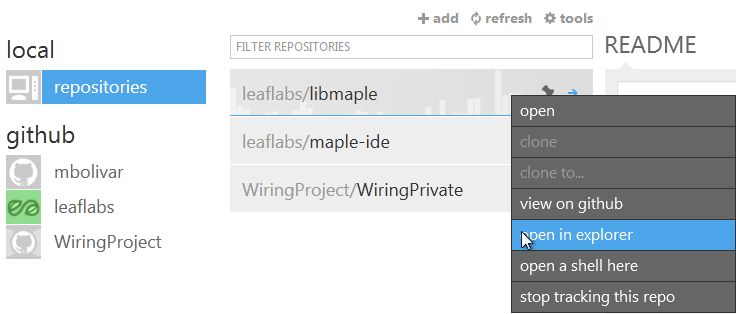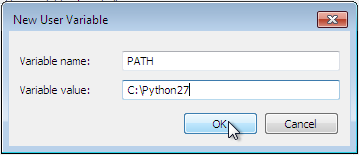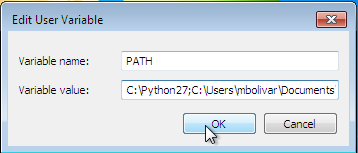Navigation
- next
- previous |
-
leaflabs.com ·
- Index »
This page contains instructions for setting up a Windows computer for use with the Unix toolchain. (Setup instructions for other operating systems are also available.)
These instructions have been tested successfully on Windows 7 Home Premium.
Contents
First, you’ll need some tools.
GitHub for Windows: this is a GUI for Git, the version control system we use for libmaple.
If you don’t have one, you need to sign up for a (free) GitHub account.
Note
If you use Git from the command line, you can clone libmaple with:
$ git clone git://github.com/leaflabs/libmaple.git
If you go this route, you don’t need a GitHub account.
Python: choose the latest 2.7.x version. (Python 3 works, but you’re on your own.)
PySerial: Choose the latest pyserial-x.y-win32.exe version.
First, make a Git clone of the libmaple repository with the following steps:
Run GitHub for Windows, and sign in using your GitHub account.
Visit libmaple’s GitHub page, and sign in to GitHub in your web browser as well.
Click on the “Clone in Windows” button on libmaple’s GitHub page, which looks like this:
Your browser may prompt you about what to do when you click the “Clone in Windows” button. Choose the option that launches the GitHub for Windows application.
Next, you’ll need to get some cross-compilers and other tools for building and uploading your programs:
Extract the .zip, and move the extracted “arm” folder into the libmaple repository’s folder.
You can open the libmaple repository folder by right-clicking libmaple in the main GitHub for Windows screen and choosing “open in explorer”:

You’ll next need to configure your system to use the various tools you’ve downloaded and installed. Do that by adding the Python and arm\bin directories to your PATH environment variable.
If you’ve never set environment variables before, this section explains what to do.
Add Python to your PATH:
Start by navigating to the folder where Python is installed on your system (this is probably C:\Python27). Right click on the folder address, then choose “Copy address as text”:

Next, open your environment variables window: from the Start/Windows menu, right click on Computer, then choose Properties > Advanced System Settings > Environment Variables. Under the “User variables for YOUR_USERNAME”, look for PATH.
If PATH is missing from the list, click “New...”.
Under “Variable Name”, write PATH. Under “Variable value”, paste the Python address you just copied, and click OK. The result looks like this:

If PATH is present in the list, click on it and choose “Edit...”.
Go to the end of the “Variable value:” text box, type a semicolon (the ; character), and then paste the path you just copied. Click OK.
Test that this worked by running the Git Shell program that came with GitHub for Windows, then running python at the command prompt. You should get a Python interpreter that looks like this:

If that worked, then close the window.
Add compiler toolchain to your PATH:
Do this by adding the arm\bin directory (earlier instructions had you move arm to the libmaple repository folder) to your PATH environment variable in the same way you added Python.
Copy the address of the arm\bin folder by right-clicking on it after navigating to it:

The PATH environment variable should exist from when you added Python to it, so make sure you choose “Edit...” from the environment variables window. Then paste the arm\bin address you copied after typing a semicolon. The final result will look something like this:

Click OK.
Great! Open a new Git Shell, then type this at the prompt and hit return to get to the libmaple directory:
cd libmaple
Warning
You must open a new Git Shell window. If you use a shell that’s already open, then the changes to PATH you just made won’t be available, and the instructions in the next section won’t work.
Now you’re ready to move on by compiling a sample program.